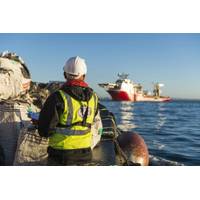Share price rises around 4 percent.
Glencore Chief Executive
Ivan Glasenberg hailed the group's results as its "strongest on record" on Wednesday, bolstered by a recovery on commodity markets and said it had the assets to meet future demand including from electric vehicles.
In line with other miners reporting this month, Glasenberg said there were "emerging inflationary pressures," but they had been offset so far by strong prices for byproducts, such as cobalt, and
Glencore (GLCNF) was able to contain costs.
Glencore's shares rose around 4 percent by 1045 GMT, outperforming the broader index.
After outstripping its rivals last year, Glencore's share price has lagged in 2018, hit by concerns about instability in Democratic Republic of Congo where it has major operations.
The mining and trading company posted full-year overall adjusted profit of $14.76 billion.
Glencore's marketing, or trading business, rose 3 percent to exceed $3 billion for the first time since 2008. It said in December its 2017 marketing EBIT (earnings before interest and tax) would be above $2.8 billion.
For the coming year, its marketing guidance is for a range of $2.2-3.2 billion, which Glencore's Chief Financial Officer Steven Kalmin said was "an all seasons" range, mindful of price crashes of the past.
Inflationary pressures were linked to higher commodity prices and currency effects, but were "nowhere near where they were in 2007-8 when we were having to scramble to get talent," he said.
Now it has recovered from the 2015-16 commodity downturn, which hit it harder than its peers, Glencore says it will avoid reckless deals, buying only when the right opportunities arise, while limiting debt and rewarding shareholders.
It recommended a 2018 distribution payout of $2.9 billion or $0.20/share, in two equal payments. That is above the minimum set out in the company's policy of $1 billion plus 25 percent of industrial cash flows.
DIFFICULT TERRAIN
As the easier access to resources diminishes, Glasenberg says there is no option but to have the courage to tackle difficult environments.
In contrast to its major peers, Glencore has significant operations in Democratic Republic of Congo, which is home to around two thirds of the world's cobalt, a vital component in electric car batteries.
The price of cobalt more than doubled last year and has risen nearly 10 percent so far this year, encouraging Democratic Republic of Congo to seek higher profits.
Its parliament in January approved a new mining code, which could see royalties on cobalt increase five-fold to 10 percent.
Glasenberg said the draft had been drawn up without consultation and told reporters the industry as a whole was "really pushing to have engagement with the mining ministry".
Much of last year's price rally in Glencore's stock was linked to its exposure to battery minerals, especially cobalt, which Glencore describes as a late-cycle commodity with a strong demand outlook.
It says the other commodities where it has leading positions, including coal are in demand following a period of under-investment, and it has also made clear it wants to increase its agricultural foothold.
In the depth of the crash, Glencore sold 50 percent of its agriculture business in 2016 to two Canadian investment funds, which helped to reduce its debts but limited some of the upside for its marketing business.
Glasenberg repeated he was keen to expand in agriculture in the Americas and was assessing opportunities, but it would not be "growth for growth's sake".
Paul Gait of Bernstein, which rates Glencore outperform, said the results were solid, and the reduction of net debt to $10.6 billion, representing a deleveraging of $5 billion over the year, was remarkable.
Referring to Glencore's ability to capitalise on an upturn in electric vehicles and energy storage systems, he said: "We see Glencore as almost uniquely positioned in this regard."
By Barbara Lewis and Arathy S Nair











